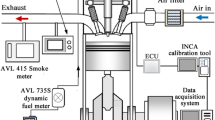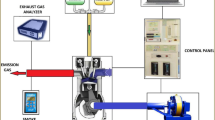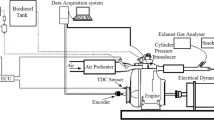Abstract
Karanja oil blended with diesel acts as a good alternative for a CI engine due to its low emission and high oxygen content as compared to pure diesel which leads to the non-toxic and biodegradable nature of the fuel. The objective of this project is to enhance the performance and emission characteristics of a diesel engine that runs on biofuel by accurately calibrating its fuel injector control parameters. To achieve this goal, the project focuses on creating optimal split injector control maps using a novel global model-based calibration approach that considers the entire range of engine speed-load conditions. To develop the model, the experimentation was conducted using the I-optimal design of the experiment technique. To establish a relationship between the calibration parameters and engine performance parameters based on experimental data, the study employed response surface methodology (RSM). With the support of a developed model and multi-objective optimization approach under equivalent importance to performance and emissions, the optimum injector control points are derived. For the developed engine map for 20% KBD (Karanja bio-diesel)-blended fuel, the BTE (brake thermal efficiency) reaches up to 30% and lower BSFC (brake specific fuel consumption) of 0.37 kg/kW-hr. After optimization, the split injector control map showed significant improvements over the un-optimized map. At 19 Nm and 3000 rpm, the optimized map resulted in a 31.36% increase in BTE and a 29.31% decrease in BSFC. Moreover, the optimization successfully balanced the trade-off between reducing nitrogen oxide (NOx) emissions and smoke emissions. However, the optimized fuel map for 20% KBD-blended fuel shows slightly lower performance compared to diesel fuel. While the optimization process led to a decrease in smoke emissions about 22.3%, it also resulted in elevated NOx emissions about 9.83% when compared to diesel fuel. Furthermore, emissions of CO and HC are reduced by 12.8% and 19.2%, respectively, in an optimized control map of 20% KBD-blended fuel compared to un-optimized map.















Similar content being viewed by others
Data availability
Not Applicable.
Abbreviations
- AC:
-
Air cooled
- BP:
-
Brake power
- BSFC:
-
Brake specific fuel consumption
- BTE:
-
Brake thermal efficiency
- BTDC:
-
Before top dead centre
- CCD:
-
Central composite design
- CI:
-
Compression ignition
- CO:
-
Carbon monoxide
- CO2 :
-
Carbon dioxide
- CRDI:
-
Common rail direct injection
- DOE:
-
Design of experiment
- DT:
-
Dwell time
- EGT:
-
Exhaust gas temperature
- FFA:
-
Free fatty acid
- FIP:
-
Fuel injection pressure
- FSN:
-
Filter smoke number
- HC:
-
Hydrocarbons
- HRR:
-
Heat release rate
- ID:
-
Ignition delay
- KBD:
-
Karanja bio-diesel
- MIF:
-
Most influential factors
- NOx :
-
Nitrogen oxide
- PIT:
-
Pilot injection timing
- PM:
-
Pilot mass
- SAP:
-
Swirl actuator position
- TDC:
-
Top dead centre
- RSM:
-
Response surface methodology
- WC:
-
Water cooled
- WCO:
-
Waste cooking oil
- 20% KBD:
-
20% Karanja bio-diesel + 80% diesel (by volume)
References
Anand R (2018) Simultaneous control of oxides of nitrogen and soot in CRDI diesel engine using split injection and cool EGR fueled with waste frying oil biodiesel and its blends. In: Sharma N, Agarwal AK, Eastwood P, Gupta T, Singh AP (eds) Air Pollution and Control. Springer Singapore, Singapore, pp 11–44
Anbu M, Balakichenin R, Muthaiyan P, Sundaramoorthy S, Amesho KTT, Subramani V (2022) Experimental investigation on the performance characteristics and emissions of a CI engine fueled with enhanced microwave-assisted Karanja seed bio-oil. Environ Sci Pollut Res https://doi.org/10.1007/s11356-022-24283-z
Awad OI, Mamat R, Ali OM, Azmi W, Kadirgama K, Yusri I, Leman A, Yusaf T (2017) Response surface methodology (RSM) based multi-objective optimization of fusel oil-gasoline blends at different water content in SI engine. Energ Conver Manage 150:222–241
Ayyasamy T, Balamurugan K, Duraisamy S (2018) Production, performance and emission analysis of Tamanu oil-diesel blends along with biogas in a diesel engine in dual cycle mode. Int J Energy Technol Policy 14(1):4–19
Channapattana S, Pawar AA, Kamble PG (2017) Optimisation of operating parameters of DI-CI engine fueled with second generation bio-fuel and development of ANN based prediction model. Appl Energy 187:84–95
Datla R, Puli RK, Velayudhan Parvathy C, Varuvel EG (2021) Effect of start of main injection timing on performance, emission, and combustion characteristics of a VGT CI engine fueled with neem biodiesel. Environ Sci Pollut Res 28(10):11942–11953
Dhingra S, Bhushan G, Dubey KK (2016) Comparative performance analysis of jatropha, karanja, mahua, and polanga based biodiesel engine using hybrid genetic algorithm. J Renew Sustain Energy 8(1):013103
Fan M, Li Z, Song S, Alahmadi TA, Alharbi SA, Shanmugam S, Jhanani GK, Brindhadevi K (2023) Optimizing biodiesel blends with green hydrogen fuel: a study on combustion duration, fuel mass burnt, engine performance and emissions. Fuel 346:128340
Jindal M, Rosha P, Mahla S, Dhir A (2015) Experimental investigation of performance and emissions characteristics of waste cooking oil biodiesel and n-butanol blends in a compression ignition engine. RSC Adv 5(43):33863–33868
Karikalan L, Chandrasekaran M (2015) Karanja oil biodiesel: a potential substitution for diesel fuel in diesel engine without alteration. ARPN J Eng Appl Sci 10(1):152–163
Kaushal N, Kumar P (2022) RSM-based parameter optimization of compression ignition engine fueled with diesel blended with two biofuels: rice bran and Karanja. J Inst Eng: Series C 103(3):485–491
Krishnamoorthi M, Malayalamurthi R, Shameer PM (2018) RSM based optimization of performance and emission characteristics of DI compression ignition engine fuelled with diesel/aegle marmelos oil/diethyl ether blends at varying compression ratio, injection pressure and injection timing. Fuel 221:283–297
Kumar AN, Kishore PS, Raju KB, Ashok B, Vignesh R, Jeevanantham AK, Nanthagopal K, Tamilvanan A (2020) Decanol proportional effect prediction model as additive in palm biodiesel using ANN and RSM technique for diesel engine. Energy 213:119072
Kumar AN, Kishore PS, Raju KB, Kasianantham N, Bragadeshwaran A (2019) Engine parameter optimization of palm oil biodiesel as alternate fuel in CI engine. Environ Sci Pollut Res 26(7):6652–6676
Langouët H, Métivier L, Sinoquet D, Tran Q-H (2011) Engine calibration: multi-objective constrained optimization of engine maps. Optim Eng 12(3):407–424
Lingfa P, Das B (2015) Energy analysis of Karanja oil as a supplementary fuel for compression ignition engine. J Urban Environ Eng 9(2):97–101
Nayee NR, Patel TM, Patel PR, Rathod GP (2017) Parametric optimization of single cylinder diesel engine for Karanja biodiesel & diesel blend for specific fuel consumption using Taguchi method. IOSR J Mech Civ Eng 14(2):41–46
Oza S, Thakar H, Kodgire P, Kachhwaha SS (2023) Utilizing an ultra-sonication process to optimize a two-step biodiesel production from Karanja oil. Environ Sci Pollut Res https://doi.org/10.1007/s11356-023-28711-6
Park S, Kim Y, Woo S, Lee K (2017) Optimization and calibration strategy using design of experiment for a diesel engine. Appl Therm Eng 123:917–928
Patel RL, Sankhavara CD (2017) Biodiesel production from Karanja oil and its use in diesel engine: a review. Renew Sustain Energy Rev 71:464–474
Petrukhin N, Grishin N, Sergeev S (2016) Ignition delay time− an important fuel property. Chem Technol Fuels Oils 51(6):581–584
Ramakrishnan P, Kasimani R, Peer MS (2018) Optimization in the performance and emission parameters of a DI diesel engine fuelled with pentanol added Calophyllum inophyllum/diesel blends using response surface methodology. Environ Sci Pollut Res 25(29):29115–29128
Rath S, Kumar S, Singh R (2011) Performance and emission analysis of blends of Karanja methyl ester with diesel in a compression ignition engine. Int J Ambient Energy 32(3):161–166
Reşitoğlu İA, Altinişik K, Keskin A (2015) The pollutant emissions from diesel-engine vehicles and exhaust aftertreatment systems. Clean Techn Environ Policy 17:15–27
Sahoo B, Sahoo N, Saha U (2009) Effect of engine parameters and type of gaseous fuel on the performance of dual-fuel gas diesel engines—a critical review. Renew Sustain Energy Rev 13(6-7):1151–1184
Saiteja P, Ashok B (2022) Study on interactive effects of CRDi engine operating parameters through RSM based multi-objective optimization technique for biofuel application. Energy 255:124499
Sathish Kumar T, Ashok B, Saravanan B (2023) Calibration of flex-fuel operating parameters using grey relational analysis to enhance the output characteristics of ethanol powered direct injection SI engine. Energy 281:128340
Sathish Kumar T, Ashok B, Senthil Kumar M, Vignesh R, Saiteja P, Ramachandra Bhat Hire K, Harshal Tote M, Pandey R, Jadhav A, Gupta A, Rastogi D, Ayyasamy T (2022) Biofuel powered engine characteristics improvement through split injection parameter multivariate optimization with titanium based nano-particle additives. Fuel 322:124178
Sellnau M, Moore W, Sinnamon J, Hoyer K, Foster M, Husted H (2015) GDCI multi-cylinder engine for high fuel efficiency and low emissions. SAE Int J Engines 8(2):775–790
Simsek S, Uslu S (2020) Determination of a diesel engine operating parameters powered with canola, safflower and waste vegetable oil based biodiesel combination using response surface methodology (RSM). Fuel 270:117496
Singh TS, Rajak U, Samuel OD, Chaurasiya PK, Natarajan K, Verma TN, Nashine P (2021) Optimization of performance and emission parameters of direct injection diesel engine fuelled with microalgae Spirulina (L.)–Response surface methodology and full factorial method approach. Fuel 285:119103
Singh Y, Sharma A, Tiwari S, Singla A (2019) Optimization of diesel engine performance and emission parameters employing cassia tora methyl esters-response surface methodology approach. Energy 168:909–918
Sivaramakrishnan K (2018) Investigation on performance and emission characteristics of a variable compression multi fuel engine fuelled with Karanja biodiesel–diesel blend. Egypt J Pet 27(2):177–186
Tadkal S, Math M (2020) Application of RSM to optimize performance and emission characteristics of a diesel engine fuelled with Karanja methyl ester and its blends with conventional diesel oil. Int J Adv Res Ideas Innovations Technol 6(2):725–733
Tamilvanan A, Ashok B, Mohanraj T, Jayalakshmi P, Dhamodharan P, Sakthivel R (2022) Chapter 5 - Effect of engine operating parameters in NOx reduction. In: Ashok B (ed) NOx Emission Control Technologies in Stationary and Automotive Internal Combustion Engines. Elsevier, pp 125–153. https://doi.org/10.1016/B978-0-12-823955-1.00005-X
Tamilvanan A, Balamurugan K, Ashok B, Selvakumar P, Dhamotharan S, Bharathiraja M, Karthickeyan V (2021a) Effect of diethyl ether and ethanol as an oxygenated additive on Calophyllum inophyllum biodiesel in CI engine. Environ Sci Pollut Res 28:33880–33898
Tamilvanan A, Balamurugan K, Mohanraj T, Selvakumar P, Madhankumar B (2021b) Parameter optimization of copper nanoparticle synthesis by electrodeposition process using RSM and CS. Mater Today: Proc 45:751–756
Tamilvanan A, Mohanraj T, Ashok B, Santhoshkumar A (2023) Enhancement of energy conversion and emission reduction of Calophyllum inophyllum biodiesel in diesel engine using reactivity controlled compression ignition strategy and TOPSIS optimization. Energy 264:126168
Tchato Yotchou GV, Kabini Karanja S, Ngayihi Abbe CV (2023) Multiobjective optimisation of feedforward control maps in dual fuel LPG/diesel engine management systems towards low consumption, low pollutants, and high torque. Int J Ambient Energy 44(1):1618–1637
Thangamuthu M, Tamilvanan A (2022) Decision support system for tool condition monitoring in milling process using artificial neural network. J Eng Res 10(4B):142–155. https://doi.org/10.36909/jer.9621
Uslu S (2020) Optimization of diesel engine operating parameters fueled with palm oil-diesel blend: comparative evaluation between response surface methodology (RSM) and artificial neural network (ANN). Fuel 276:117990
Vairavel M, Chandrasekaran M, Vivek P, Kumar V (2020) Empirical performance analysis of VCR engine fuelled with Karanja oil and various additives using ANOVA technique. Int J Ambient Energy 41(4):369–373
Venkatanarayana B, Ratnam C, Rao RU, PrasadaRao K (2017) Multi-response optimization of DI diesel engine performance parameters using Karanja methyl ester by applying Taguchi-based principal component analysis. Biofuels 8(1):49–57
Verma P, Sharma M, Dwivedi G (2016) Prospects of bio-based alcohols for Karanja biodiesel production: an optimisation study by Response Surface Methodology. Fuel 183:185–194
Vignesh R, Ashok B (2021) Deep neural network model-based global calibration scheme for split injection control map to enhance the characteristics of biofuel powered engine. Energ Conver Manage 249:114875
Wong PK, Gao XH, Wong KI, Vong CM (2018) Efficient point-by-point engine calibration using machine learning and sequential design of experiment strategies. J Franklin Inst 355(4):1517–1538
Xu H, Yin B, Liu S, Jia H (2017) Performance optimization of diesel engine fueled with diesel–jatropha curcas biodiesel blend using response surface methodology. J Mech Sci 31:4051–4059
Yoon M, Lee K, Sunwoo M (2007) A method for combustion phasing control using cylinder pressure measurement in a CRDI diesel engine. Mechatronics 17(9):469–479
Yoon SK, Ge JC, Choi NJ (2019) Influence of fuel injection pressure on the emissions characteristics and engine performance in a CRDI diesel engine fueled with palm biodiesel blends. Energies 12(20):3837
Acknowledgements
B. Ashok acknowledges the support of the Management of Ahmadu Bello University, Zaria, Nigeria for conducting this research as part of his Post Doctoral Research in the Biofuel Research group of the Mechanical Engineering Department.
Funding
The research is financially supported by the Royal Academy of Engineering, UK, under the HEPSSA Programme (Grant No: HEP-2021-127).
Author information
Authors and Affiliations
Contributions
AB: resources, investigation, and writing—original draft preparation
VR: methodology, conceptualization, and writing—original draft preparation
KMU: supervision, resources, and investigation
TA: investigation and writing—original draft preparation
KG: conceptualization and investigation
Corresponding author
Ethics declarations
Ethical approval
Not applicable.
Consent to participate
Not applicable.
Consent for publication
Not applicable.
Competing interests
The authors declare no competing interests.
Additional information
Responsible Editor: Philippe Garrigues
Publisher’s Note
Springer Nature remains neutral with regard to jurisdictional claims in published maps and institutional affiliations.
Rights and permissions
Springer Nature or its licensor (e.g. a society or other partner) holds exclusive rights to this article under a publishing agreement with the author(s) or other rightsholder(s); author self-archiving of the accepted manuscript version of this article is solely governed by the terms of such publishing agreement and applicable law.
About this article
Cite this article
Bragadeshwaran, ., Rajasekar, V., Usman, K.M. et al. Split injection strategy control map development through prediction-based calibration approach to improve the biodiesel-fuelled diesel engine characteristics. Environ Sci Pollut Res (2023). https://doi.org/10.1007/s11356-023-29905-8
Received:
Accepted:
Published:
DOI: https://doi.org/10.1007/s11356-023-29905-8




